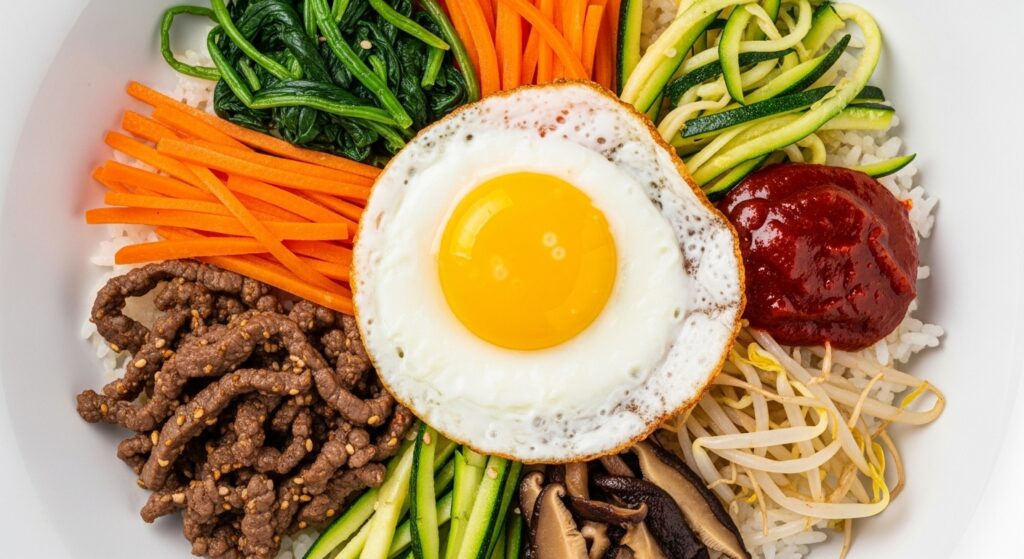A Common Mistake

Ask any foreigner visiting Korea for the first time, and they’ll likely say, “Oh, that’s Korean sushi!” when they see Kimbap (also spelled Gimbap, 김밥).
It’s an understandable mix-up — both are rolled in seaweed and sliced neatly into bite-sized pieces. But that’s where the similarities end.
Kimbap is not sushi. It’s a completely different story — one that speaks to Korea’s love for simplicity, convenience, and flavor all rolled into one. While sushi often focuses on the raw and delicate taste of fish, Kimbap celebrates the balance of seasoned rice, fresh vegetables, and cooked fillings. It’s a roll made not for presentation but for practicality — the perfect travel companion for everyday life in Korea.
More Than Just a Roll

In Japan, sushi is associated with delicacy and ceremony — sometimes even luxury. In Korea, Kimbap represents everyday life. It’s what families pack for picnics, students bring on field trips, and hikers eat at the top of a mountain.
For foreigners, this is what makes Kimbap fascinating — it’s casual, humble, yet deeply comforting. It doesn’t require fancy ingredients or elaborate techniques, just simple components brought together with care. Many Koreans say the best Kimbap comes not from restaurants but from their mothers’ hands, wrapped early in the morning before a school trip or long drive.
Each slice is a memory — of family, preparation, and anticipation of the day ahead.
The Art of Balance

Inside a single roll, Kimbap holds a world of color and texture — golden egg strips, bright carrots, tender spinach, yellow pickled radish (danmuji), and seasoned rice brushed with sesame oil. Each slice offers a perfect balance: salty, sweet, nutty, and fresh all at once.
This sense of harmony reflects the Korean philosophy that even simple foods should feel complete. Every bite of Kimbap delivers that balance between nutrition, color, and taste. It’s also deeply symbolic — combining various elements into one harmonious whole, much like Korean society’s emphasis on community and cooperation.
A Cultural Snapshot

If sushi represents ceremony, Kimbap represents spontaneity. Koreans make it whenever they go somewhere — to work, to the park, even on road trips.
It’s portable, filling, and easy to share.
Foreigners often love how it symbolizes mobility and connection — a meal you can eat anywhere, yet still feel at home. That’s why Kimbap is more than food; it’s a cultural icon. You’ll find it in school lunches, convenience stores, and even on high-speed trains across Korea. It’s as much a part of Korean daily life as coffee or rice.
For another dish that captures the joy of gatherings and shared moments, try Japchae (Korean Glass Noodle Stir-Fry). Like Kimbap, it’s often served at family celebrations and brings color, texture, and harmony to any Korean table.
Kimbap Around the World
As Korean food spreads globally, Kimbap has become an ambassador of casual Korean dining. Cafes in Los Angeles, London, and Sydney now serve “fusion Kimbap” with avocado, tuna, or spicy bulgogi fillings. Vegan versions using tofu or mushrooms have also gained popularity.
Even with these modern twists, the soul of Kimbap remains the same — rice, vegetables, and care rolled into one. It’s a food that bridges tradition and modernity, comfort and creativity.
👉 Want to try it yourself? Scroll down to the recipe card below for a step-by-step guide to making your own Kimbap at home.
Conclusion
Kimbap may look like sushi at first glance, but it tells a completely different story — one of family, convenience, and everyday joy. It’s a taste of Korea’s fast-paced yet warm lifestyle, wrapped in seaweed and brushed with sesame oil.
For foreigners, Kimbap offers more than flavor; it offers a glimpse into the rhythm of Korean life. Whether enjoyed on a picnic, in a lunchbox, or on a long journey, Kimbap embodies Korea’s rolling story of harmony and togetherness.
As more people around the world discover Kimbap, it continues to evolve while keeping its comforting essence. Whether you roll it with traditional ingredients or modern twists, the spirit of Kimbap — simplicity, sharing, and harmony — remains timeless.
If you love Korean lunchbox classics, you might also enjoy my Gyeran-mari (Rolled Omelette) recipe — it’s the perfect side to complete your homemade Kimbap set.

Kimbap (Korean Seaweed Rice Roll)
Equipment
- 1 Bamboo mat For rolling gimbap
- 1 Frying pan For eggs and carrots
- 1 Mixing bowl For seasoning rice
- 1 Sharp knife For slicing rolls
Ingredients
- 2 cups cooked short-grain rice slightly warm
- 1 tsp sesame oil to season rice
- 0.5 tsp salt
- 2 sheets dried seaweed (gim/nori) shiny side down when rolling
- 2 eggs beaten and cooked into a thin omelette
- 0.5 carrot julienned and lightly sautéed
- 4 leaves spinach blanched and seasoned
- 2 sticks imitation crab meat or ham optional protein
- 2 strips yellow pickled radish (danmuji)
- 1 tbsp sesame seeds for garnish
- 1 tsp soy sauce optional dipping sauce
Instructions
- Cook short-grain rice and let it cool slightly. Mix with sesame oil and salt for flavor.
- Make a thin omelette, slice into strips. Sauté carrots until soft. Blanch spinach, squeeze water, and season lightly.
- Lay a sheet of seaweed shiny side down on a bamboo mat. Spread a thin layer of rice, leaving 2 cm space at the top.
- Arrange egg, carrot, spinach, crab (or ham), and pickled radish horizontally across the center.
- Roll tightly using the mat, pressing gently to shape. Seal with a bit of rice at the edge.
- Brush sesame oil on top, sprinkle sesame seeds, and slice into bite-size pieces.
- Serve with kimchi or light soup for a complete Korean-style meal.


